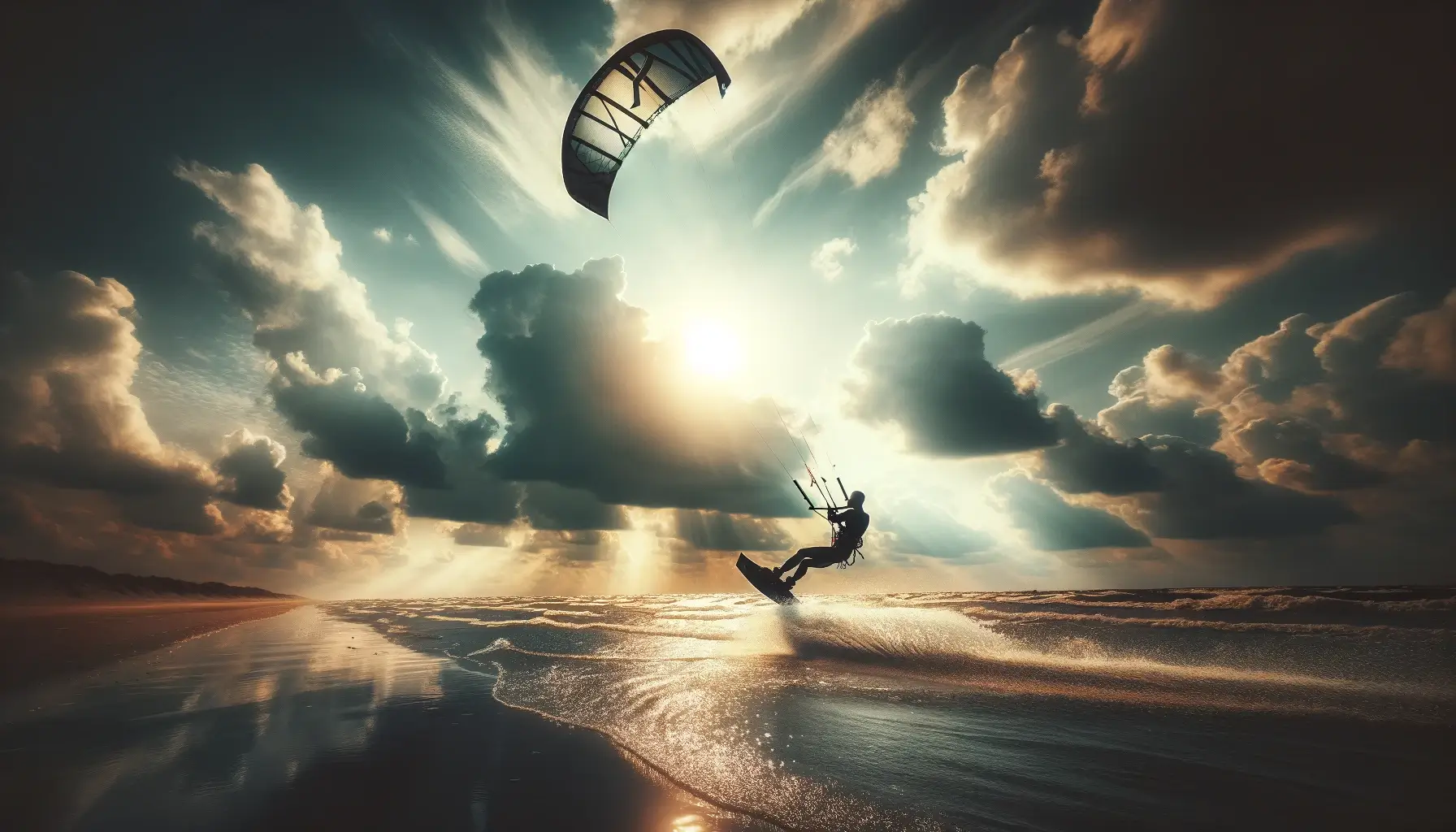Elevate your kiteboarding with pivotal kite jump techniques. From seamless lift-off to controlled landings, we lay out the critical moves to amplify your air time. Expect clear-cut tips you can apply immediately to make your next kitesurfing jump your best.
Key Takeaways
- Kite control, board positioning, and body posture are essential for height and jump stability, with line tensions being a critical but often overlooked aspect.
- Timing, speed, and correct kite positioning are the secret sauce for perfecting kite takeoffs and achieving the desired height.
- Learning from common mistakes, like overspending the kite or incorrect loading and popping, is as essential as practicing advanced jumping techniques for progression.
The Fundamentals of Kite Jumping

Mastering a few fundamental aspects is critical to a successful kite-jumping adventure. Of course, kite control is an integral part of kite jumping.
Steering the kite back into the direction of the power zone will give you that vertical lift you need for a successful jump. Managing the kite’s angle and flight pattern will ensure a steady pull and a controlled height as you ascend.
Your board positioning is another fundamental aspect. Aligning the board correctly with the wind and having your feet securely strapped in is crucial to your jumping success. Then, there’s your body posture.
Maintaining a strong body posture with your knees slightly bent and back straight helps balance during kite jumps and absorbs shock during landings.
A glance ahead and keeping your arms bent with your hands on the control bar aids better kite manipulation and stability in the air.
Understanding Line Tensions
Line tension, an often overlooked yet vital aspect of kite jumping, is the most important thing worth discussing. Line tensions are pivotal in creating the energy to boost high during kite jumps.
You can maintain a steady line of tension by building even foot pressure across, sending the kiteboard, and learning to ride with power in the kite.
Remember that line tensions are a consequence of proper technique, not the primary cause. This technique incorporates aspects of lift and drag that are not always considered in common diagrams and videos.
High jumps are achieved through the correct blend of line tension, tensions, and other kite jumping techniques rather than line tensions alone.
Board Positioning and Edging
Your board’s position and how you use the board edge are just as crucial as line tensions for a successful kitesurfing jump.
Begin your takeoff by cruising on edge onboard flat water at a comfortable speed with reasonable power in the kite’s swing and pop. A moderate edge on the flat water while building speed upwind will give you a more dynamic swing and pop and a powerful takeoff swing and pop.
To counteract the rising pull, send tension on the heel side edge of the board flat and the kite up. Drop it and point the board’s heel-side edge with your hips toward the flat water. Push through tension on the board edge with the back and heel-sideboard edge together, ensuring a rigid heel-sideboard edge upwind.
The right combination of board, heel-side edge positioning, and edging toward flat water will set you up for a smooth ride and controlled takeoff.
Body Posture and Movement
Body posture and movement are potent factors in kite jumping. Correct body posture during kite jumping includes looking upwind over the shoulder, dropping the hips closer to the water, and straightening the front leg to maintain and send the kite board’s edge.
Maintaining balance during the jump is of utmost importance. To prevent unwanted rotation, lean against the kite’s pull and avoid looking over the back shoulder or at the water.
Watching the intended landing area helps kiteboarders spot their landing and maintain balance while descending.
Perfecting Your Takeoff

Having covered the fundamentals, it’s time to focus on perfecting your takeoff. Every second is critical from when you decide to leap off the water until you’re airborne. It’s crucial to build tension with the pop and speed before takeoff.
Techniques such as bending the knees to generate energy and extending rapidly while sending the kite up will result in a more powerful jump.
There are multiple ways to do small jumps and takeoffs —going small jump first with pop on the front hand of the kite, heading up and stomping small jump in big air, or combining these methods for fun and varied small jumps and styles.
Learning how to load and land a small jump with pop is the first step to mastering kitesurfing small jumps and takeoffs with pop. This sets the stage for all subsequent small jumps and takeoff techniques.
Timing Your Takeoff
Any successful kitesurfing jump hinges on precise timing. The best time to start the jump is when the kite is between 11 and 1 o’clock positions, which will vary based on the wind window and riding direction.
The power stroke of the kite, which occurs as the kite swiftly transitions from a higher to a lower position within the wind window, should align with your takeoff.
Just before the jump, relax and send the kite off; send the kite off the edge, heading slightly downwind. Then, edge the kite back to upwind and redirect it back in its direction upwind as the kite reaches the zenith. Practicing takeoff timing in various wind conditions will enhance your muscle memory and sense of timing.
Building Speed for Takeoff
When it comes to kite jumping, speed is paramount. The faster you go, the higher you hope you’ll fly. A board with some rocker is beneficial when riding in choppy water because it helps maintain traction and minimizes bouncing, allowing for a slow build-up of speed needed for a successful kitesurfing jump.
A common technique for maintaining and building speed involves softly sending the kite to around 11 o’clock, followed by a more aggressive movement to noon and immediately hard edging and popping.
Ensuring adequate speed before a downwind jump is crucial as it is directly tied to the subsequent forward momentum and height achieved during the jump. Aggressively diving and lifting the kite as you ride can create the necessary pull to maintain tension in the lines and increase speed.
Kite Positioning During Takeoff
Just as a bird adjusts its wings for a perfect takeoff, correct kite positioning is necessary for maximum lift and control. Proper kite positioning during takeoff is crucial for achieving the maximum lift and power for successful jumps.
The kiteboarding jump technique, also known as the kitesurfing jump, involves the following key steps:
- Send the kite softly from 10-10:30 to 11 o’clock, then aggressively to noon for maximum elevation.
- Execute a pop right after sending the kite to the zenith. A clean pop is achieved by moving the kite briskly across to the other side of the wind window while pushing hard with the back foot, ensuring the lift starts as the rider leaves the water.
- Adjust the angle of attack through sheeting in or out to control the height and distance of the jump, adding an element of precision to the lift generated during takeoff.
Mastering Small Jumps (1-3 meters)
Not all kite jumps have to reach great heights. Small jumps can be just as thrilling and are a great way to build confidence and technique.
When launching off small waves for jumps, maintain the bar and pull an even bar and board edge up, allowing the wave to provide the lift. Ensure you accelerate, dive past the bar of the break, land on the bar of the ramp, pull past the bar, dive, and ride the board downwind and edge hard for an intense pop.
Keeping the kite positioned around 70 degrees and using front-hand pressure to redirect and pull it forward during the jump will give you optimal control and power generation while kite flying.
For a controlled heel-first landing, follow these steps:
- Have your body weight on the balls of your feet.
- Pivot quickly down on the heel side after the jump to regain line tensions.
- Shift weight to the front foot during the landing.
Control the kite with both hands on the bar. Move your weight back to your front hand, scissor your legs for a stable ascent and descent, and lift your knees to prepare for landing.
Achieving Bigger Air (3 meters or more)

Once comfortable with smaller jumps, you can aim for smaller jumps and greater heights. Achieving big air in kite jumping involves keeping as much line tension as possible. Pull the bar down by bringing hands to hips and knees up to hands to maintain tension on the steering lines and prevent swinging off balance.
For maximum height, the kite should be at 1 o’clock when the rider reaches the peak of the jump, not before. Kite looping can be used as an advanced technique to create more lift during a jump.
Incorporating advanced wake style tricks such as the Megaloop and Board Off can significantly increase kite jumps’ height and style factor.
Common Mistakes and How to Avoid Them
Like any other skill, kite jumping involves a learning curve with mistakes and corrections. Mastering kite control during a jump involves getting comfortable with shifting your balance when moving the kite, primarily during descent, to stabilize your flight.
Common mistakes in the kite jumping technique include failing to properly load and pop or over-manipulating the kite, which can interfere with jump performance.
Incorrect timing when sending the kite and back foot to land too early in the jump direction can generate an unwanted and dangerous increase in float and result in a hard landing.
To ensure a controlled landing, it is recommended to put more weight on land than the kite and back foot and travel slightly downwind while landing from a kitesurfing practice jump direction.
Over-Sending the Kite
Overseeing the kite means sending it too far back in the sky or wind window during a jump, which can lead to a dangerous loss of control and kite stability.
For example, if you overspend, you may inadvertently watch something go past, fly past, or fly or fall downwind past the direction of the point of your kite. This can cause the kite to lose it, drop out of the sky, break, or lose itself, hindering the jump’s success.

To prevent over-sending the kite, focus on the send timing and avoid steering the kite too far back, especially during strong wind conditions.
Not Redirecting the Kite Forward
Redirecting the kite forward during a jump is crucial for maintaining control and stability and preserving forward momentum. Failing to do so can result in unwanted forward rotation and potentially lead to a crash.
Timing the kite’s redirection is crucial; for example, redirecting to send the kite back to land or flying too soon causes dangerous hard landings. Too late can lead to the kite stalling and potentially crashing.
When redirecting the kite forward, avoid looking at it excessively to maintain balance and control. This can flatten the kiteboard and cause a loss of edge, resulting in the kite traveling too far behind.
Proper kite bar redirection involves pulling the kite bar towards land with the hips and diving the kite bar in the direction with the front hand before landing to ensure that the kite bar and kite are powered and the kite bar is directed forward.
Incorrect Loading and Popping
Loading and popping are two fundamental techniques in kite jumping. Correctly executing these moves can significantly impact your jump’s height and control.
Practicing the load and pop technique is essential for gaining air without relying too heavily on the kite, which helps prevent problems such as overspending.
Loading and popping off a wave should be executed quickly and deliberately to maintain the speed built up during and send the kite back into approach and pop. Gradually adding the pop and sending the kite back into jumping maneuvers should only be done after mastering getting air through proper loading and popping.
Advanced Jumping Techniques

Let’s explore some advanced techniques if you’re ready to elevate your kite-jumping skills. Jumping without sending the kite involves focusing more on board movement, leading to less upward pull and more downwind movement.
Advanced riders strive for technical Big Air moves such as:
- The double loop, which requires kites that can catch the rider and regenerate line tensions effectively
- The Hinterberger, which is a Railey with a frontside 360
- The Frontflip to Wrapped is a frontflip with frontside 360 where the rider doesn’t pass the handle after landing.
The KGB is a heel-side backroll with a handlebar pull-pass backside 360, and the Moby Dick is a tantrum with a backside 360 handlebar pull-pass, adding complexity to the flip.
Unhooked Jumps
Unhooked jumps offer a unique challenge and freedom of movement. They require precise kite control as the rider is not hooked into the harness lines.
To maintain control during unhooked jumps, keep elbows tucked in, body weight low, and arms bent to avoid being pulled off the edge.
To initiate an unhooked jump, follow these steps:
- Send the kite back
- Drop weight back over the trailing foot
- Push the board away to start the ascent
- Unhook just before popping to prepare for the jump
- Once the arms extend, explode off the back leg using the heel for resistance.
Downwind Jumps
Downwind jumps offer a unique and challenging kite-jumping experience. Releasing the kite board’s edge downwind is critical to executing a successful downwind jump. It is crucial to stop resisting the rail break point, allowing the kite to pull and send the kite rider off the wind and towards it.
To maximize both the height and stability of downwind jumps, it is essential to:
- Soften the knees to achieve a board flat position.
- Lift the kite slightly when transitioning downwind to raise the rider and flatten the board.
- Focus on correct timing and technique.
These tips will help improve your kite control and enhance your downwind jumping skills.
Wakestyle Tricks
Lastly, add style to your kite jumps with wake-style tricks. Wakestyle tricks refer to sophisticated maneuvers in kite jumping, typically involving slow, complex moves like handle passes, where the control bar is passed around the rider’s body.
Mastering wake-style tricks, such as high-altitude handle passes, can give competitors an edge by showcasing a higher skill level.
Dedicated practice focusing on control bar manipulation and body movement is necessary to incorporate wake-style tricks into one’s kite jumping repertoire.
Training Exercises for Improved Kite Jumping

As with any sport, regular practice and training are essential for kite jumping. Repetitive carving into the wind on both sides strengthens leg muscles and improves edging technique, which is vital in maintaining an edge during jumps.
Practice sending the kite for a jump with varying degrees of power to help you understand the control and timing needed to send the kite for a high jump.
Use choppy water conditions to learn to control the kite in the unpredictable wind for smoother high jump transitions. Integrate board grabs into high jump practices to improve air control and coordination, facilitating smoother transitions.
As your ability and confidence increase, progress to more complex maneuvers like downloops and heli loops.
Video Resources and Tutorials
Video tutorials are an invaluable resource, especially for visual learners. They provide practical demonstrations that help you master kite-jumping techniques.
Experts like Sam Light have created comprehensive video tutorials on kite jumping, which are accessible on Kiteworld Magazine’s website or YouTube video channel.
Overview
So, there you have it—a comprehensive guide to mastering kite jumping. We’ve covered everything from the fundamentals of kite control, line tensions, kiteboard positioning, and body posture to perfecting your takeoff, mastering both small and big jumps, avoiding common mistakes, and even exploring advanced jumping techniques.
One common mistake in kitesurfing is neglecting proper kite control, which can lead to loss of balance and unexpected crashes.
Remember, kite jumping this fall is not just about the fun and thrill of soaring high above the water and sky; it’s also about understanding the wind, mastering your equipment, and honing your skills. So, are you ready to take flight for fun this fall?
Frequently Asked Questions
How do you jump a kite?
To jump a kite, ride comfortably and gradually move upwind until the kite is at 11 or 1 o’clock. Then, steer the kite back in the opposite direction and push harder with your back foot to initiate and send the kitesurfing jump.
How do you land a big kitesurfing jump?
When landing a giant kitesurfing jump board downwind, land with your kiteboard pointing crosswind or upwind. You jump and start traveling smoothly as you send the kiteboard downwind to ensure a soft landing. And remember, the higher the kite, the smoother the landing.
What is surfing with a kite called?
Surfing with a kite is called kitesurfing or kiteboarding. It involves using wind power with a large power kite to pull a rider across a water, land, or snow surface.
Can anybody kite surf?
You don’t have to be super fit or incredibly strong to fly a kitesurf. A general fitness level is beneficial, but good technique is more critical to flying than great strength.
What is the importance of line tensions in kite jumping?
Line tension is crucial in kite jumping as it helps create the energy required to achieve greater height. Jumpers can maximize their performance by maintaining even foot pressure and harnessing the kite’s power.







